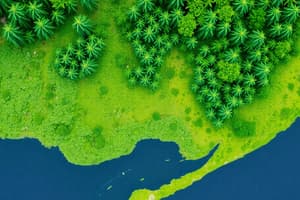Podcast
Questions and Answers
Which factor does not influence terrestrial biomes?
Which factor does not influence terrestrial biomes?
- Geographic position
- Salinity (correct)
- Vegetation
- Precipitation
Which term describes a smaller, more detailed unit that includes both biotic and abiotic factors?
Which term describes a smaller, more detailed unit that includes both biotic and abiotic factors?
- Population
- Habitat
- Ecosystem (correct)
- Biome
What does altitude refer to in the context of biomes?
What does altitude refer to in the context of biomes?
- The level of sunlight penetration in an area
- The amount of moisture in the air
- The average temperature of a region
- The distance from Earth's surface to a given point (correct)
Which aquatic factor is not influenced by the properties of water?
Which aquatic factor is not influenced by the properties of water?
What characterizes the climate of a region?
What characterizes the climate of a region?
Flashcards are hidden until you start studying
Study Notes
Biomes
- Distinct regions with similar characteristics, including geographic, ecological, and biological features.
- Characterized by flora (plants) and fauna (animals)
- Divided into terrestrial and aquatic biomes
Terrestrial Biomes
- Influenced by precipitation, geographic position, and vegetation
- Varying levels of rainfall influence plant life and animal adaptations
Aquatic Biomes
- Distinguished by salinity, sunlight, pH, temperature, and currents
- Salinity describes the amount of salt in water
- Sunlight availability impacts the depth and types of organisms present
- pH measures the acidity or alkalinity of water
- Temperature fluctuations affect marine life and distribution
- Currents create movement and influence water circulation
Key Factors Affecting Biomes
- Latitude: Distance from the equator influences temperature and precipitation patterns.
- Atmospheric Humidity: Amount of water vapor in the air, affected by temperature, influences precipitation.
- Altitude: Distance from Earth's surface to a given point, influences temperature and precipitation.
- Climate: Averages of atmospheric conditions like temperature, wind, pressure, and precipitation, determine long-term biome characteristics.
Studying That Suits You
Use AI to generate personalized quizzes and flashcards to suit your learning preferences.




